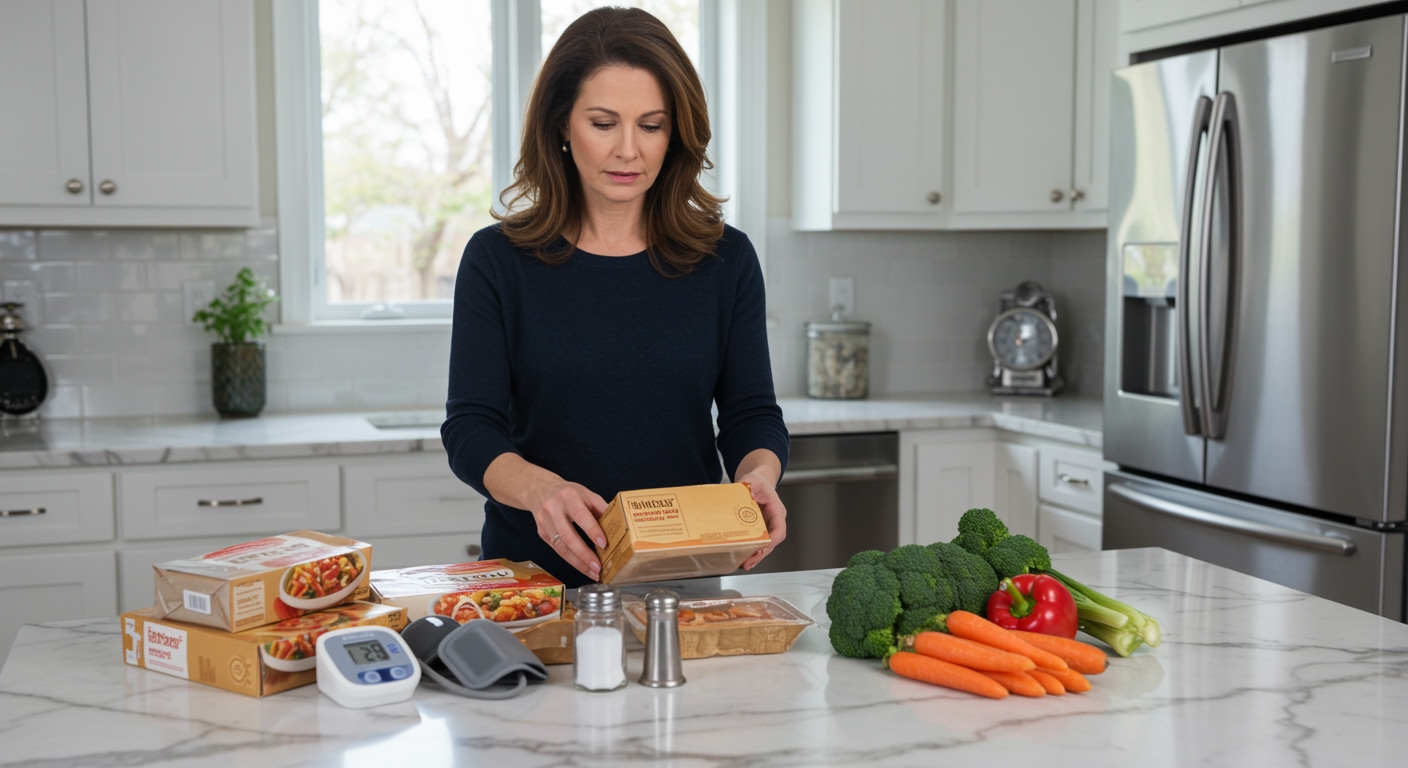✪ Key Takeaway: Not all frozen dinners are off-limits for hypertensive patients, but most contain dangerously high sodium levels that require careful selection.
Introduction
Your doctor just told you that your blood pressure is too high and you need to watch your sodium intake.
You stand in the frozen food aisle staring at rows of convenient dinner options wondering if your busy lifestyle just became impossible to manage.
Hi, I’m Abdur, your nutrition coach and today I’m going to explain exactly which frozen dinners you can safely eat with high blood pressure and which ones could send your numbers through the roof.
Why Do Most Frozen Dinners Spell Trouble for Blood Pressure?
The average frozen dinner contains between 800 to 1500 milligrams of sodium per serving.
That single meal delivers nearly your entire daily sodium limit if you have high blood pressure.
The American Heart Association recommends that people with hypertension consume no more than 1500 milligrams of sodium per day.
Food manufacturers add excessive sodium to frozen meals for three main reasons.
First, sodium acts as a natural preservative that extends shelf life and prevents bacterial growth during long storage periods.
Second, freezing and reheating processes destroy natural flavors, so companies compensate by adding salt and artificial flavor enhancers to make food taste appealing.
Third, sodium creates food addiction by triggering dopamine release in your brain, which keeps you buying more products from the same brand.
✪ Fact: Your taste buds adapt to high sodium levels within just two weeks of reducing salt intake.
What Happens When You Eat High-Sodium Frozen Meals?
When you consume a high-sodium frozen dinner, your body immediately begins retaining extra water to dilute the excess salt in your bloodstream.
This increased blood volume forces your heart to work harder to pump blood through your arteries.
Your blood pressure can spike within 30 to 60 minutes after eating a sodium-heavy meal and remain elevated for several hours.
The extra fluid also puts additional strain on your kidneys as they struggle to filter and eliminate the excess sodium and water.
Over time, this repeated stress damages the delicate blood vessels in your kidneys, creating a dangerous cycle where kidney damage leads to even higher blood pressure.
Many people experience bloating, swelling in their hands and feet, and increased thirst after eating high-sodium frozen meals.
These symptoms are your body’s warning signs that you have consumed more sodium than your cardiovascular system can handle safely.
✪ Pro Tip: Drink extra water after accidentally eating a high-sodium meal to help your kidneys flush out excess salt.
How Can You Find Blood Pressure-Friendly Frozen Options?
Look for frozen dinners that contain 600 milligrams of sodium or less per serving.
This target allows you to enjoy a convenient meal while leaving room for sodium from other foods throughout your day.
Read the nutrition facts panel carefully because serving sizes can be misleading.
Some packages that look like single servings actually contain two or more servings, which means you need to multiply the sodium content accordingly.
Choose frozen meals that feature whole grains, lean proteins, and plenty of vegetables as these foods naturally contain less sodium than processed ingredients.
Avoid frozen dinners with cheese sauces, cured meats, pickled vegetables, or multiple sauce packets as these ingredients are sodium bombs.
Consider frozen meals labeled as heart-healthy, low-sodium, or specifically designed for people with dietary restrictions as these options typically contain more reasonable sodium levels.
✪ Note: Foods labeled as reduced sodium still contain 25% less sodium than the original version, which might still be too high.
What Are Better Alternatives to Traditional Frozen Dinners?
Frozen vegetables without added sauces or seasonings make excellent building blocks for quick, healthy meals.
You can steam frozen broccoli, carrots, or mixed vegetables in your microwave and add your own herbs and spices for flavor without excess sodium.
Plain frozen proteins like chicken breast, fish fillets, or turkey patties allow you to control exactly how much salt goes into your meal.
Frozen brown rice, quinoa, or whole grain pasta provide convenient complex carbohydrates that you can prepare quickly and season to your taste preferences.
Batch cooking and freezing your own meals gives you complete control over ingredients while maintaining the convenience you need for busy weeknights.
Spend one weekend afternoon preparing portion-controlled meals in freezer-safe containers using fresh ingredients and minimal added salt.
This approach costs less than buying commercial frozen dinners and provides better nutrition for managing your blood pressure long-term.
✪ Pro Tip: Freeze homemade meals in single-serving containers for the same convenience as store-bought frozen dinners.
The Bottom Line
You do not need to completely avoid all frozen dinners if you have high blood pressure, but you must become a detective when reading nutrition labels.
Convenience should never come at the cost of your cardiovascular health because small daily choices create your long-term health outcomes.
Share your favorite low-sodium frozen meal discoveries or homemade freezer meal ideas in the comments below to help other readers make heart-healthy choices.
References
At NutritionCrown, we use quality and credible sources to ensure our content is accurate and trustworthy. Below are the sources referenced in creating this article:
- Archwell Health: How to Choose a Healthy Frozen Meal
- GoodRx: Are Frozen Meals Unhealthy
- WithPower: Inside Low Sodium Frozen Meals
- CSPI: Cold Hard Facts About Frozen Foods





